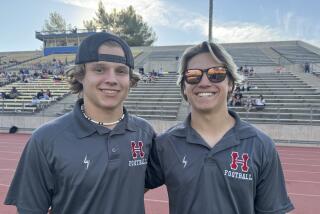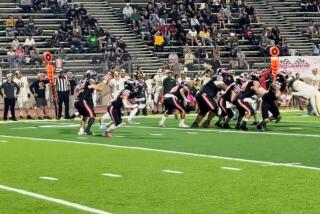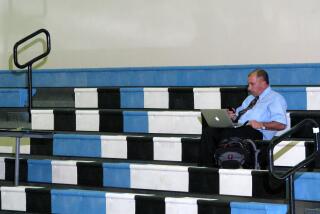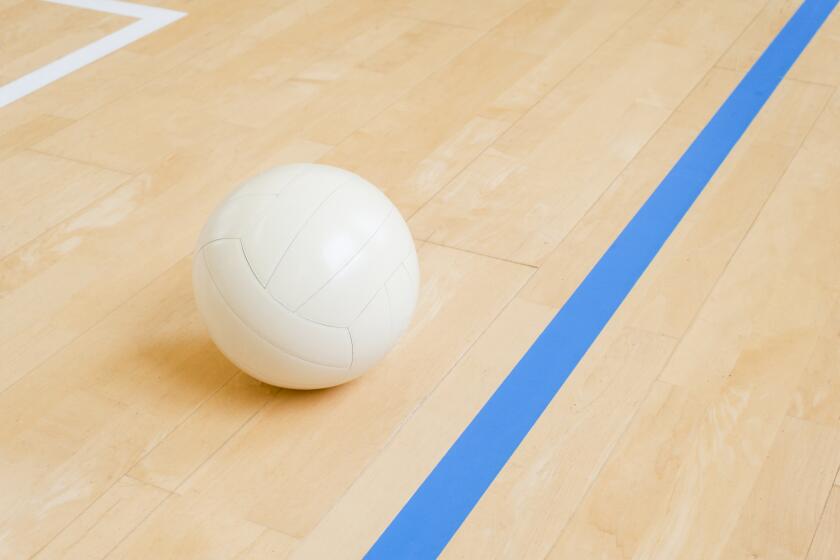Trying to Dodge a Bullet : Thousand Oaks Faced With Task of Disarming Hart’s Run-and-Shoot
Imagine the plight of Rob Elliott, defensive coordinator at Thousand Oaks High, as he prepares for the onslaught from the northeast.
This is a man who has devised more defensive schemes than General Patton. He has scribbled more Xs than an Algebra instructor.
In a piece of football fiction, Elliott stands near midfield at Thousand Oaks and points toward the Santa Clarita Valley. His troops--a mixture of veterans and plebes--kneel around him.
“Gentlemen,” his voice booms, “they call themselves the Indians and they will be coming from the northeast.”
A plebe glances over his shoulder. That will be his first mistake.
“They are an unusual tribe,” Elliott screams. “They seldom confer. They appear unorganized. Then they run and shoot.”
A hand is raised. “Don’t you mean they shoot and run?” the rookie asks.
The rookie’s second, and last, mistake.
“Son,” Elliott says, “go throw some wood on the fire.”
The run-and-shoot offense is the 1990s answer to bell-bottom jeans and platform shoes.
The newfangled offense is bigger than cowboy hats in Texas, where the Houston Oilers and the University of Houston Cougars run and shoot like it was a 100-yard saloon fight.
The breakneck offense first arrived at Hart High on assistant coach Dean Herrington’s chalk board in 1984 when Herrington coached the school’s sophomore team. Herrington, who became varsity offensive coordinator when his brother Mike became head coach in 1989, has refined the offense, creating what Canyon Coach Harry Welch calls “a monster.”
Hart’s run-and-shoot, no-huddle attack scorched Canyon, 32-27, Friday night at College of the Canyons. Welch last was seen dashing for cover.
“If they execute the way they did against us and continue to make normal high school progress, no one will beat them,” Welch said.
That is not what Thousand Oaks wants to hear as the Lancers prepare for tonight’s 7:30 nonleague contest at Thousand Oaks High. Thousand Oaks is ranked No. 2 in the area by The Times. Hart is ranked No. 3.
Over the past 12 years, Elliott has put together defenses that have been regarded as some of the finest in the area. The Lancers are a swarming group that hit harder than the truth. Coach Bob Richards hands defensive players prestigious Green Helmets--in honor of outstanding ability and leadership--as if they were Purple Hearts.
But the Lancer brass is shaking in its boots. Coaches have spent endless hours watching videotapes, trying to come up with a defensive scheme that will take firepower out of the run-and-shoot.
“It is very worrisome,” Elliott said. “We have got to slow them down.”
Thousand Oaks’ 4-3 alignment, which has served as a brick wall halting so many high-powered offenses in the past, will remain the Lancers’ first line of defense.
“We certainly haven’t put in a whole new defense to stop the run-and-shoot,” said Lancer assistant Dan Murphy, who coaches defensive backs and linebackers. “I think that’s where some schools get into trouble. We don’t have a million fronts, stunts and covers that will confuse the kids. We want to make sure our assignments are sound.”
Yet the Lancers have added a few twists.
“We’ll adjust a little bit, like move our linebackers a little and change some lineman alignments up front,” Elliott said. “It won’t be anything earthshaking. In fact, when you see it, you might not even know we’ve adjusted. But I still would rather not share it yet.”
The key, Elliott says, is deception.
“We’ll make it look like it’s a certain alignment, then change it at the last second,” he said. “A linebacker might look like he’s going to blitz, then fall back into coverage.”
If Canyon’s blitzing is testament, the Lancers should not shoot the gap too hastily. The Cowboys blitzed incessantly in the second half, a tactic that first caught Hart by surprise but eventually led to the Cowboys’ demise.
“I’m not sure that was the right decision,” Welch said. “That may be like being at Las Vegas and trying to beat the house.”
Elliott says Thousand Oaks, which opened by defeating Saugus, 35-9, must pressure Hart senior quarterback Ryan Connors, who completed 22 of 42 passes for four touchdowns and a school-record 399 yards last week.
“We hope and pray for teams to blitz,” Dean Herrington said. “Our kids get excited because they know that’s when we’re going to break the big plays.”
The run-and-shoot is designed to spread a defense over the field like a balloon stretched to its limit. And the no-huddle approach, in which Connors receives the plays via signals from Dean Herrington on the sidelines, is the pin waiting to pierce it.
“The no-huddle limits your substitutions and forces you to stay pretty simple on defense because you don’t have the time to get in stuff like the stunt calls,” Murphy said.
Hart sends out on patterns as many as five receivers at a time. The receivers--who know whether Connors will take a short drop, long drop, or roll out--examine the defensive alignment. Then they just try to get open, like children running around in a street pickup game.
“It can look like total chaos,” Dean Herrington said. “We try to get our receivers in good matchups, one on one. At the professional and college level, it’s more difficult because you have guys running 4.2 (seconds in the 40-yard sprint). But not many high school players can play man-to-man defense.”
When Connors clicks with his receivers, the offense can appear infallible. The burden to make Hart fallible falls on Murphy, who coaches the defensive backs and linebackers.
“You can’t come in with a nickel package and put six defensive backs on the field to stop the pass because Hart’s running game will eat you up,” Murphy said. “On the other hand, you can’t come in with a five-man rush to pressure the quarterback, because that leaves an open receiver. The trick is to come up with a balanced defense that will take away the run game and be solid against the pass.”
Preparing for the run-and-shoot is like playing without a helmet: There’s likely to be a headache or two.
“It’s designed to put the defense in a situation that no matter what you do, you’re wrong,” Murphy said. “The Hart coaches keep refining it in order to stay one step ahead of the defense.”
Dean Herrington’s commitment to the run-and-shoot became total this season when he dropped the tight end and fullback positions from the offense. Usually, the Indians employ two slot backs, two split ends, and a tailback. Occasionally, there are no setbacks.
Last week, Connors completed 22 passes to six receivers. Each caught at least two, and Deriek Charles, the tailback, led the team with six receptions for 90 yards.
“I don’t look at their offense as much as I look at the personnel that is executing their offense,” Richards said. “(Hart) has great athletes running that offense. They have Connors, (Doug) Distaso, (Aron) Miyata, (Davis) Delmatoff, and a guy who’s been a tremendous key for them, Deriek Charles.”
Charles, who carried nine times for 54 yards against Canyon, provides the run in the run-and-shoot. “He’s a guy who’s going to keep you absolutely honest,” Richards said.
Thousand Oaks’ defense, which will have six juniors in its starting lineup, will look for help from its offense. The Lancer offensive line averages 240 pounds, which paved the way for 316 yards in 45 carries against Saugus.
Thousand Oaks will need similar time-consuming drives--its specialty--which would confine the run-and-shoot to the sidelines where Hart could only stand-and-aim.
More to Read
Get our high school sports newsletter
Prep Rally is devoted to the SoCal high school sports experience, bringing you scores, stories and a behind-the-scenes look at what makes prep sports so popular.
You may occasionally receive promotional content from the Los Angeles Times.






